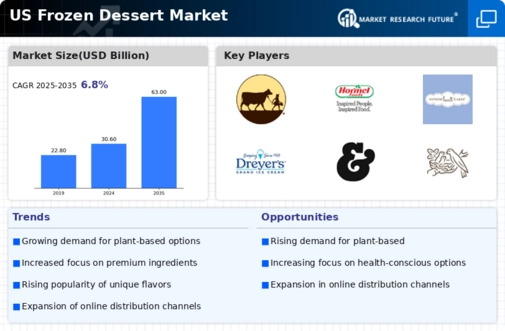Plant-Based Alternatives
The growing demand for plant-based alternatives is significantly influencing the frozen dessert market. With an increasing number of consumers adopting vegan or flexitarian diets, the market for dairy-free frozen desserts is expanding rapidly. Reports indicate that the plant-based frozen dessert segment has seen a growth rate of over 20% annually, reflecting a shift in consumer preferences towards healthier and more sustainable options. Brands are responding by developing products made from almond, coconut, and oat bases, which not only cater to dietary restrictions but also appeal to environmentally conscious consumers. This trend indicates a potential for innovation and market expansion, as companies that invest in plant-based offerings may find themselves well-positioned to meet the evolving demands of the market.
Innovative Flavor Profiles
The frozen dessert market is experiencing a notable shift towards innovative flavor profiles that cater to diverse consumer preferences. As consumers seek unique and adventurous taste experiences, manufacturers are introducing exotic flavors such as matcha, lavender, and spicy chocolate. This trend is supported by data indicating that approximately 30% of consumers are willing to try new flavors, which drives product development and marketing strategies. The introduction of limited-edition flavors and seasonal offerings further enhances consumer interest, leading to increased sales. Additionally, the rise of social media platforms has amplified the visibility of these unique flavors, encouraging consumers to share their experiences. This dynamic environment suggests that companies focusing on flavor innovation may capture a larger market share in the competitive landscape of the frozen dessert market.
Premium Quality Ingredients
The emphasis on premium quality ingredients is reshaping the frozen dessert market. Consumers are increasingly discerning about the components of their food, leading to a preference for products made with natural, organic, and high-quality ingredients. Data suggests that around 40% of consumers are willing to pay a premium for frozen desserts that feature clean labels and minimal processing. This trend has prompted manufacturers to source high-quality ingredients, such as organic fruits and artisanal chocolates, to enhance product appeal. As a result, brands that prioritize ingredient quality may not only attract health-conscious consumers but also differentiate themselves in a crowded market. This focus on premium ingredients is likely to drive growth and foster brand loyalty within the frozen dessert market.
Seasonal and Limited-Time Offerings
The frozen dessert market is witnessing a surge in seasonal and limited-time offerings, which create a sense of urgency and excitement among consumers. Brands are increasingly launching products that align with holidays, events, or seasonal flavors, such as pumpkin spice in the fall or peppermint during the winter holidays. This strategy not only boosts sales during specific periods but also encourages repeat purchases as consumers seek to experience these exclusive flavors. Market data indicates that limited-time offerings can increase sales by up to 25% during promotional periods. This trend suggests that companies leveraging seasonal marketing strategies may enhance their visibility and profitability in the competitive landscape of the frozen dessert market.
E-commerce Growth and Online Availability
The rise of e-commerce is transforming the frozen dessert market, providing consumers with greater access to a variety of products. Online shopping has become increasingly popular, with data showing that online grocery sales have surged by over 30% in recent years. This shift allows consumers to explore a wider range of frozen dessert options, including niche and artisanal brands that may not be available in traditional retail outlets. The convenience of home delivery and the ability to compare products easily are driving this trend. As a result, companies that invest in e-commerce platforms and online marketing strategies may find new opportunities for growth and customer engagement within the frozen dessert market.























Leave a Comment